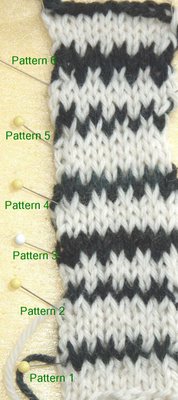Here, without further ado, are
 the patterns. For technical niceties, please notice the imaginary asterisk immediately after the colon in each Row, and do not disregard the invisible 'Repeat from * to end of row' immediately following the . MC = main color, CC = not main color.
the patterns. For technical niceties, please notice the imaginary asterisk immediately after the colon in each Row, and do not disregard the invisible 'Repeat from * to end of row' immediately following the . MC = main color, CC = not main color. - Row 1: (MC) K1 sl 1. Row 2: (CC) K. Row 3: (MC) Sl 1 K1.
- Row 1: (MC) K1 sl 1. Row 2: (CC) K. Row 3: (MC) K1 sl 1.
- Row 1: (CC) K1 sl1. Row 2: (CC) K. Row 3: (CC) Sl 1 K1.
- Row 1: (CC) K1 sl 1. Row 2: (CC) K. Row 3: (MC) K1 sl 1.
- Row 1: (MC) K1 sl1. Row 2 (CC) Sl 1 K1. Row 3: (CC) K1 sl 1. Row 4: (MC) Sl 1 K1.
- As Pattern 5, but please insert a Row 2.5 in between rows 2 and 3. Row 2.5: (CC) K.
Patterns 5 and 6 were knit with a slip stitch technique, but they are not slip stitch patterns. So, what's the difference between slip stitch technique and slip stitch patterns? I dare not speak officially, since I have no reference books on the subject - although I hear Barbara Walker covers them quite well in one of her Treasuries. To my mind, though, a slip stitch technique is what you do when you're working with two different colors in one row in a Fair Isle style pattern, and you choose to only work one color at a time. You'll notice that in Row 1 of Pattern 5, I worked the stitches that were in the main color, and then in Row 2, I went back and used the other color to knit all the stitches not knit in the previous row. Some people prefer this method to working with both colors at once. Some authors heartily dissuade knitters from even attempting such a daring feat. Rosemary and I will go on record as cheerfully ignoring that advice, although in our own separate ways.
A slip stitch pattern uses a slip stitch technique, but goes one step further. It has elongated stitches - but not the kind created by extra wraps around the needle which are later dropped. Look at Pattern 1. See the humongous dark Vs? Those were created by slipping the dark green stitch in Row 3 of the pattern. They sure stick out like a sore thumb, and are meant to. Slip stitch patterns can be quite pleasing to the eye. One, a Mosaic pattern, is going to end up on the Tea Cozy I keep talking about making. Patterns 1-4 all have elongated stitches in them, stitches that were pulled just a bit larger than others in their row when they were slipped and had to stretch further than just the next row. In Patterns 5 and 6, no stitch is elongated since Rows 1 and 2, combined, knit each stitch once, and Rows 3 and 4 combined do the same. No stitches have to stretch anywhere.
In other knitting, I finished the second reincarnation of the Embossed Leaf Socks,
and made good progress on the shawl. In my scholastic endeavours, I am parsing portions of The Merchant of Venice, and enjoying 3rd declension nouns in the beta version of Elementary Greek: The Third Year (my title, not the publisher's).
Mom has been feeling a bit better every day since Monday, and today she actually feels good. I, being a dutiful daughter, told her to play sick for a few more days while her body continues to recover. Mom is working on a Hardanger bread cloth. I'll have to put a picture of it up here when she finishes it. It's her first Hardanger!
Does anyone besides me find it totally unfair that KnitPicks has come out with a new yarn? A Merino/Pima blend. I'm glad it's worsted weight. I can resist stuff that thick fairly well. If it was fingering weight, I'd have it in my shopping cart already. There's another new yarn, Spinnaker. A super bulky cotton they didn't even mention in their promotional e-mail.
This week I'd like to get about 200 rows done on the shawl, get another pair of socks on the needles, order the yarn for my next shawl, make some headway in G. K. Chesterton's 'The Man Who Was Thursday', and keep up with general house stuff. Oh, homeschool too.
1 comment:
I want to say thanks, too. I have often wondered about these techniques myself.
Post a Comment